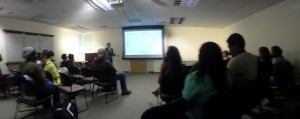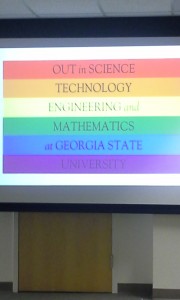
Georgia State’s Out in Science, Technology, Engineering, and Mathematics (oSTEM) President Robin Baidya described the goals he has for the University’s newest LGBTQA-driven student organization at a general interest meeting on Wednesday, Apr. 11.
oSTEM at Georgia State’s mission is to provide services, support, education, and networking opportunities to students with majors in science, technology, engineering, and mathematics, who identify as part of a gender minority, sex minority, or sexual minority and their allies.
Having been a member of oSTEM during his undergraduate career at Ohio State, Robin Baidya explained to over 22 intrigued students how he saw Ohio State’s chapter of oSTEM go about accomplishing this mission, and how he plans to accomplish it at Georgia

State.
“When I think of providing services to students, I think more in terms of individualized support,” Baidya said. “For example, at one of our meetings at Ohio State, we had two graduate students come in to give a presentation on what strategies LGBT students need to keep in mind when applying for jobs.”
The oSTEM organization is a national program dedicated to education and support of students in the STEM fields. The non-profit organization started as a single chapter in 2005, and now encompasses more than 50 chapters across the United States. oSTEM at Georgia State is a newly chartered organization and plans to become an official chapter of the national 501(c)(3) oSTEM society.
According to Baidya, during his time at Ohio State, one of the most beneficial effects the oSTEM organization had upon its members came through support. Academic support, social support and emotional support are all parts of the cornerstone from which this organization was founded.
“One way that I found was very effective to get members to start talking to each other was through the screening of movies,” Baidya said.
According to Baidya, after watching these movies, members had a topic through which to communicate with each other. At meetings, in efforts to create bonds among one another, members would always have the talking point of the last screened movie to fall back upon.
“It was hard to find films that were about issues facing members of the LGBT community,” Baidya said. “However, we would always try to find movies focused on the issues facing our fellow STEM students and professionals, and how to use STEM-based approaches to understand gender, sex, and sexuality.”
Moreover, according to Baidya, the oSTEM support system is designed to help LGBT students well beyond the boundaries of their weekly meetings. The oSTEM community’s support system extends to the platforms of social networking.
“We will discuss topics at our weekly meetings all the time on our Facebook page, our Twitter handle, and even through our Instagram profile,” Baidya said. “I would also like to organize social events with members of our organization, such as dinners following our weekly meetings.”
The third and fourth portions of oSTEM at Georgia State’s mission fall into the realms of education and networking, respectively.
According to Baidya, he and the members of his executive board plan to invite STEM professionals to speak at weekly meetings about their academic, social, and professional experiences and their work in STEM research and education.
“I’m already in talks with many experienced LGBT professionals in all sectors of the economy,” Baidya said. “My executive board members and I are working on collaborations with STEM departments, centers, institutes, and organizations both within and outside the bounds of Georgia State University to produce events relevant to STEM students and their allies.”
Baidya’s comments upon his plans for this organization really incited an interest from several students in attendance at the meeting. After he finished explaining how he planned to help members through education and networking, Psychology major Danny Brown stood up, and stated how she felt about this organization.
“I am very excited,” Brown said. “I think this is will be a very good thing. When Tiffany told me I was very excited because this feels safe. Hearing about this organization makes me feel like I’m not alone, and it’s really good to know, and more students should have the opportunity to join a group like this.”
oSTEM plans to advance its methods of support and education outside of the collegiate realm. Baidya spoke about the positive effects he believes programs such as oSTEM can have upon students in the K-12 education track.
“Yes, we plan on facilitating conversations, forums, and workshops with high school students on issues facing STEM students, professionals and their allies,” Baidya said. “We envision a chain of mentorship: undergraduate students mentoring high school students, graduate students mentoring undergraduate students, and professionals mentoring both undergraduate and graduate students.”
To accomplish its goals, Baidya made it clear that maintaining active relationships with STEM departments and organizations both within and outside of Georgia State University, including the Alliance for Sexual and Gender Diversity, will be absolutely necessary to achieve oSTEM’s mission.
“Interacting with other LGBT organizations will be especially important during our first few years,” Baidya said. “We have to focus on developing our membership base and increasing our visibility in the Georgia State community.”
There are currently five LGBT driven student organizations at Georgia State: The Alliance for Sexual and Gender Diversity; CPS- PRIDE; BlackOUT; OUTLaw; and now oSTEM. According to oSTEM at Georgia State’s Vice President Zakia Kiminta, however, they all work as one voice.
